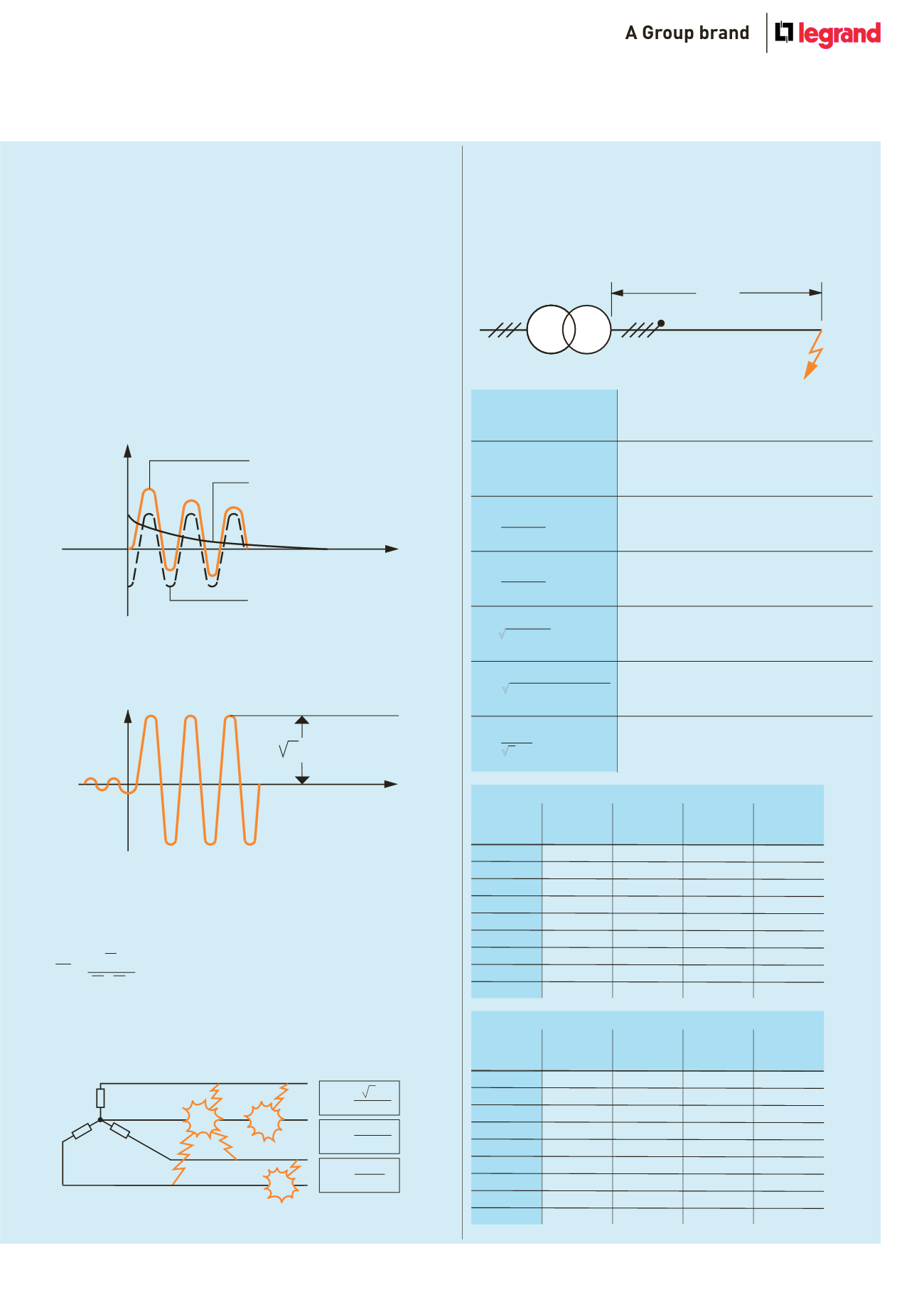

89
All dimensions (mm) are nominal
n
Short circuit withstand
The CEI 64-8 standard indicates that, for the protection of the circuits
of the system, it is necessary to allow for devices aimed at interrupting
short circuit currents before these become dangerous due to the
thermal and mechanical effects generated in the conductors and the
connections. In order to size the electric system and the protection
devices correctly, it is necessary to know the value of the estimated
short circuit current at the point where this is to be created. This value
enables selection of the correct protection devices based on their own
tripping and closing powers, and to check the resistance to electro-
dynamic stress of the busbar supports installed in control panels, and/or
of the busbar trunking systems
Characterisation of short circuit current
The estimated short circuit current at a point of the user system is the
current that would occur if at the considered point a connection of
negligible resistance was created between conductors under voltage.
The magnitude of this current is an estimated value that represents
the worst possible condition (null fault impedance, tripping time long
enough to enable the current to reach the maximum theoretical values).
In reality, the short circuit always occurs with significantly lower effective
current values
The intensity of the estimated short circuit current essentially depends
on the following factors :
• power of the cabin TRANSFORMER, meaning that the higher the
power, the higher the current
• length of the line upstream the fault, in the sense that the longer the
line, the lower the current
In three phase circuits with neutral it is possible to have three different
types of short circuit :
• phase-phase
• phase-neutral
• balanced three phase (most demanding condition)
The formula for the calculation of the symmetric component is :
Where :
• E = the phase voltage
• ZE = the secondary equivalent impedance of the TRANSFORMER
measured between the phase and the neutral
• ZL = the impedance of the phase conductor only
Short circuit current
Unidirectional component
Symmetric component
Time (t)
Current (I)
Andamento reale
Time (t)
Current (I)
Andamen o reale
In
2 Icc
ZE
Icc3~
IccFN
IccFF
IccFF = 2ZE + 2ZL
3 E
IccFN = ZE + 2ZL
E
Icc3~ = ZE + ZL
E
E
= phase voltage
ZE
ZE
Icc =
E
ZE+ZL
1 : lcw for 1 second
L (m)
S (mm
2
)
P (kVA)
n
Short circuit withstand
(continued)
Analytical determination of short circuit currents
In order to calculate the value of the estimated short circuit current
at any point of the circuit, it is sufficient to apply the formulas shown
below, knowing the impedance calculated at the origin of the system
up to the point being assessed. In the formulas shown below, the value
of the short circuit power is considered infinite and the short circuit
impedance is equal to 0. This makes it possible to define short circuit
current values higher than the actual ones, but generally acceptable
RL
= resistance of the line upstream (m)
Line resistance
r
= specific line resistance (m/m)
RL = r • L
L
= upstream line length (m)
Line reactance
XL
= upstream line reactance (m)
XL = x • L
x
= specific line reactance (m/m)
TRANSFORMER resistance
RE
= transformer secondary equivalent resistance (m)
Pcu
= transformer COPPER losses (W)
In
= transformer rated current (A)
TRANSFORMER impedance
ZE
= transformer secondary equivalent impedance (m)
Vc
= phase voltage (V)
Vcc%
= percentage short circuit voltage
P
= transformer power (kVA)
TRANSFORMER reactance
XE
= transformer secondary equivalent reactance (m)
Short circuit impedance
Zcc
= total short circuit impedance (m)
Estimated short circuit current
Icc
= symmetric component of the short circuit current (kA)
Vc
Icc =
√
3 Zcc
1000 Pcu
RE =
3 In
2
XE =
√
ZE
2
– RE
2
Zcc =
√
(RL + RE)
2
+ (XL + XE)
2
Vcc% V
2
c
ZE =
100 P
Aluminium
Rating
kA
kA
kA
kA
(A)
3 phase
3 phase
1 phase
1 phase
lcw
1
lpk
lcw
1
lpk
630
36
76
22
48
800
42
88
25
55
1 000
50
110
30
66
1 250
75
165
45
99
1 600
80
176
48
106
2 000
80
176
48
106
2 500
150
330
90
198
3 200
160
352
96
211
4 000
160
352
96
211
Copper
Rating
kA
kA
kA
kA
(A)
3 phase
3 phase
1 phase
1 phase
lcw
1
lpk
lcw
1
lpk
800
45
95
27
57
1 000
50
110
30
66
1 250
60
132
36
79
1 600
85
187
51
112
2 000
88
194
53
116
2 500
88
194
53
116
3 200
170
374
102
224
4 000
176
387
106
232
5 000
176
387
106
232



















